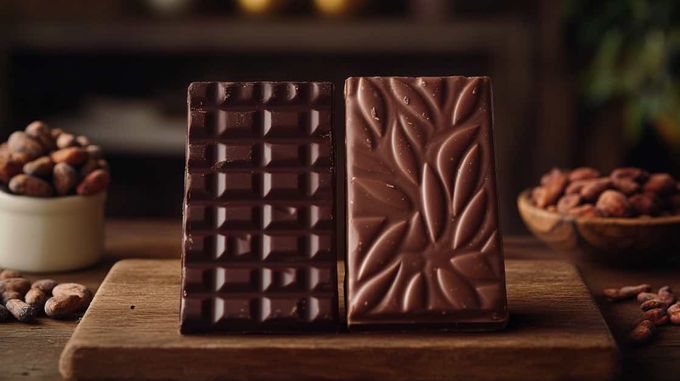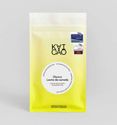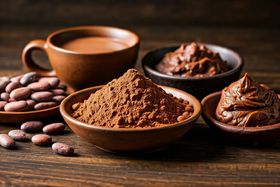Dark vs. Milk Chocolate: Which Has Better Quality & Taste?
Unravel the secrets of chocolate: This in-depth look examines the complexities of flavor, texture, and health benefits, revealing which chocolate reigns supreme
Published February 3, 2025

The age-old debate between dark and milk chocolate continues to spark passionate discussions among chocolate lovers worldwide. However, the reality is more nuanced than simply declaring one category superior.
Quality, processing methods, and ingredients are crucial in determining a chocolate's actual value, regardless of its classification.
» Savor the exquisite taste of our milk and dark chocolate collections
Primary ingredients and their impact
Dark chocolate
Dark chocolate is generally defined by its high cacao content. While the exact percentage can vary slightly, it's typically considered 60% cacao solids or higher. Dark chocolate usually contains cacao butter, cacao beans, and a sweetener like dates or sugar.
It's usually made of three key ingredients:
- Cacao solids: Derived from roasted and ground cacao beans, they provide an intense, bittersweet flavor and rich, dark color.
- Cacao butter: The natural fat that gives chocolate its smooth, creamy texture and melt-in-your-mouth quality. It's also extracted from cacao beans.
- Sugar: This is added to balance the bitterness of the cacao solids. The higher the percentage of cacao solids, the less sugar is typically added, resulting in a more intense and less sweet flavor.
» Find out why dates are an ideal fiber-rich alternative to refined sugar
Milk chocolate
In contrast, milk chocolate has a lower cacao content, typically 10% to 50%. It usually incorporates milk powder or alternative milk into its composition, significantly altering its flavor profile. This combination of two fats contributes to its sweeter, creamier, and milder taste.
While milk chocolate retains some of the cacao's characteristic flavor, the sweetness of the milk dominates.
Other common ingredients in milk chocolate include:
- Sugar: Milk chocolate often contains more sugar than dark chocolate to enhance its sweetness further.
- Lecithin: This emulsifier helps to blend the ingredients smoothly and prevent separation.
- Vanilla extract: Often added for flavor enhancement.
- Artificial flavors and colors: Some milk chocolates may contain artificial flavors and colors to enhance their appearance and taste.
It's important to note that additives don't automatically indicate lower quality. High-quality milk chocolate can exist with carefully selected additives, though they may make it more challenging to appreciate the subtle flavor notes of the cacao beans.
» Want the health benefits of cacao? Discover why ritual cacao is the answer
Milk vs. dark: Which is healthier?
Dark chocolate boasts a higher cacao content, translating to more antioxidants called flavanols. These compounds have been linked to improved heart health, lower blood pressure, and better blood flow. It's also typically lower in sugar than milk chocolate, a significant factor for weight management and blood sugar control.
Milk chocolate retains some of the beneficial compounds found in cacao, albeit in smaller amounts. It can also be a calcium and vitamin D source, particularly if fortified.
Plant-based chocolates made with ingredients like almond, cashew, oat, or coconut milk offer a dairy-free option for those seeking alternatives. Camel milk chocolate is gaining popularity and is touted for its potential health benefits and unique flavor profile.
Ultimately, the "healthier" choice depends on individual preferences and dietary needs. Enjoying chocolate in moderation, regardless of the type, is key.
Understanding chocolate quality
Both dark and milk chocolate begin with cacao beans, but their paths diverge during production. While dark chocolate typically contains more cacao than milk chocolate, these percentages alone don't tell the whole story.
Here's what makes high-quality chocolate in either category:
- Premium cacao beans sourced from reputable farms using sustainable practices create the foundation for excellent chocolate, whether dark or milk
- Careful fermentation and roasting of beans preserve delicate flavor compounds and determine the depth of taste
- Minimal processing and controlled temperatures maintain the beneficial compounds in both varieties
- Clean ingredient without unnecessary fillers or artificial additives indicate quality regardless of category
Milk chocolate quality
Milk chocolate often gets dismissed as inherently inferior, but premium varieties can offer both enjoyment and benefits:
- High-quality milk chocolate can contain 40–50% cacao content, significantly more than the 10% minimum requirement.
- Alternative milk sources like camel milk or plant-based options can offer unique nutritional profiles and better digestibility.
- Sustainable and organic milk sources contribute to both environmental responsibility and product quality.
- Premium milk chocolate makers often use better-quality cacao beans and more careful processing methods.
Dark chocolate quality
Not all dark chocolate delivers the health benefits commonly associated with this category. Several factors determine its actual nutritional value and taste:
- The source and quality of cacao beans greatly influence both flavor profile and antioxidant content.
- Processing methods can either preserve or destroy beneficial compounds—excessive heat or poor handling can diminish health benefits.
- Some manufacturers add extra fats, artificial sweeteners, or preservatives to dark chocolate, compromising its potential benefits.
- The percentage of cacao solids doesn't guarantee quality—poorly processed 85% dark chocolate may offer fewer benefits than well-made 65% dark chocolate.
» Explore the art of premium bean-to-bar chocolate
Texture and Taste: A Sensory Exploration
Chocolate's sensory experience is a fascinating journey of texture and flavor, with dark and milk varieties offering distinctly different profiles that cater to diverse palates.
Dark Chocolate
The distinctive qualities of dark chocolate stem from its high cacao content and minimal additional ingredients.
- Dark chocolate features a firmer, more structured texture that ranges from slightly crumbly to satisfyingly snappy.
- The higher cacao butter content contributes to a dense and substantial mouthfeel that challenges the palate.
- Artisanal varieties demonstrate remarkable textural variation, showcasing the potential for complexity in chocolate production.
The flavor profile of dark chocolate is equally compelling. Its taste is an intricate exploration of pure cacao expression, offering a sophisticated sensory experience beyond simple sweetness. Bittersweet notes dominate, presenting a complex flavor that can include subtle undertones of earth, fruit, wood, and even tobacco.
» Discover the taste of 85% Peruvian chocolate from the Piura region
Milk Chocolate
Milk chocolate's composition creates a different sensory profile than its darker counterpart.
- Adding milk fat creates an exceptionally smooth and creamy texture that yields effortlessly on the tongue.
- Milk chocolate melts more readily, releasing its flavors quickly.
- The softer mouthfeel allows for a more immediate flavor distribution across the palate.
Flavor-wise, milk chocolate prioritizes sweetness and accessibility. Caramel and vanilla notes emerge prominently, softening the chocolate's inherent bitterness and creating a more approachable taste profile.
Mass-produced chocolates, milk and dark, have standardized textures and flavor profiles. In contrast, bean-to-bar production showcases the unique characteristics of specific cacao beans and artisanal crafting techniques.
Processing: A crucial factor in chocolate quality
Processing techniques profoundly influence the quality of both dark and milk chocolate, regardless of their cacao content.
- Excessive processing degrades flavor and reduces beneficial antioxidants. High heat and prolonged conching diminish delicate compounds and valuable nutrients.
- Careful processing enhances complexity. Precise fermentation, controlled roasting, and gentle handling preserve flavor and unlock the unique terroir of cacao beans.
Mass production often prioritizes consistency and shelf life, sacrificing nuanced flavors. Industrial processes characterized by high heat and additives create uniform but less complex chocolate. Emulsifiers, extra fats, and stabilizers can mask the natural complexity of high-quality cacao.
» Explore the complexities of tempering chocolate
The value of minimal processing
At KAICAO, we approach processing with a focus on individuality. We treat each batch of beans uniquely, adjusting methods to highlight the specific characteristics of that particular cacao. This involves shorter roasting times, minimal grinding, or avoiding additional fats that dilute the cacao's natural richness.
The goal of minimal processing isn't simply preservation but elevation. By respecting the cacao's inherent qualities, KAICAO creates chocolates that tell a story of origin, craft, and careful cultivation. The result is a bar offering a more authentic, nuanced experience—whether dark or milk—transcending simple percentages and elevating the art of chocolate making.
How to identify premium chocolate
Looking for high-quality chocolate? Here's what to look for on labels and packaging:
- A high cacao percentage should be clearly stated, even for milk chocolate.
- The ingredients list should be minimal, with cacao products appearing first.
- Look for certifications such as Fair Trade and organic designations. Keep in mind that smaller producers may not always have access to these certifications
- Origin information, including specific farms or regions, often indicates higher quality and better transparency.
- Premium chocolates typically cost more than €5 per bar, reflecting the quality of ingredients and careful production methods.
» Understand how traditional chocolate is made
The verdict: Quality transcends type
True excellence emerges through meticulous craftsmanship, thoughtful sourcing, and a deep respect for cacao's inherent complexity. Whether you're drawn to dark's intense, sophisticated bitterness or milk's creamy, comforting sweetness, quality is more important than categorization.
At KAICAO, our chocolates challenge conventional boundaries. By prioritizing clean, pure ingredients and avoiding unnecessary additives, our chocolates are delicious and a true sensory experience. Whether you're a dark chocolate lover or prefer the lighter taste of milk chocolate, there's something to satisfy everyone.
» Indulge in premium milk and dark chocolate from KAICAO
Indulge in the highest quality bean-to-bar chocolate
Disclaimer: The chocolate information provided by KAICAO is intended for educational purposes related to chocolate products. We encourage you to embrace the chocolate experience, savor each moment, and explore the world of chocolate with passion.







